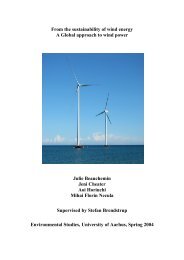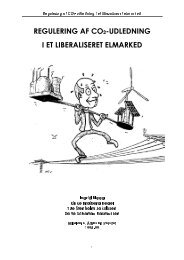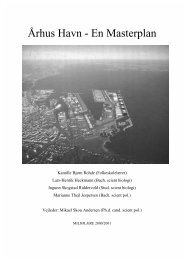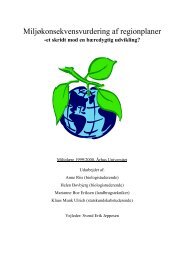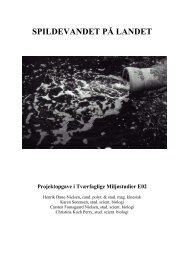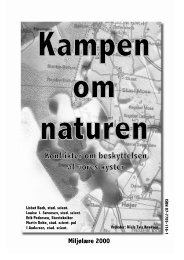University of Aarhus ECOTOURISM AS A WAY TO PROTECT ...
University of Aarhus ECOTOURISM AS A WAY TO PROTECT ...
University of Aarhus ECOTOURISM AS A WAY TO PROTECT ...
You also want an ePaper? Increase the reach of your titles
YUMPU automatically turns print PDFs into web optimized ePapers that Google loves.
Ecotourism as a sustainable way to protect nature<br />
One <strong>of</strong> the ecotourism milestones is to protect pristine and fragile<br />
ecosystems. But how can ecotourism contribute to protect the nature This could<br />
be done by funding and by managing and promoting ecotourism correctly.<br />
One thing is regulation <strong>of</strong> the number <strong>of</strong> tourists. This is every individual<br />
aspect from one national park to another, and it is very difficult to put a general<br />
ceiling on the visitor number. This should be done on local, regional or national<br />
levels, and not on an international level. Still there should be some control by<br />
the government or else there is a possibility that the number <strong>of</strong> tourists will<br />
increase, because tourism is <strong>of</strong>ten a very capitalistic industry which <strong>of</strong>ten tries to<br />
evade the rules where possible. This was, for instance, the situation on the<br />
Galapagos. The government had made some limitation on the number <strong>of</strong> boats,<br />
but boat owners got around this limitation by adding more berths to the boats<br />
and some bought permits from owners <strong>of</strong> smaller boats. In that way they<br />
increased the number <strong>of</strong> tourist without adding more boats.<br />
A way to decrease the number <strong>of</strong> tourists is to increase the cots, for<br />
instance by increasing the entrance fees. Most people will pay more money if<br />
they get a special and unique experience, and if they know they are participating<br />
in conserving the National Park.<br />
Tourists should leave no footprint when they visit national parks. This is<br />
very difficult to practise in reality, because the tourist will always have a direct<br />
or indirect impact on the nature.<br />
Directly, tourists can affect the environment simply by their presence, as<br />
the example with the cheetah shows. And they can have an influence on the<br />
animals’ behaviour, if animals get used to being fed by humans. They can also<br />
affect the vegetation on the most visited places. The cost will be soil erosion and<br />
loss <strong>of</strong> vegetation (Roe, 1997).<br />
72





